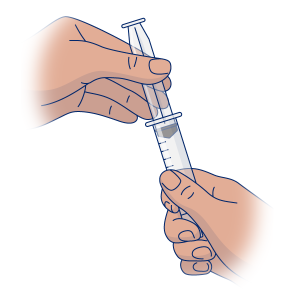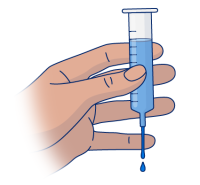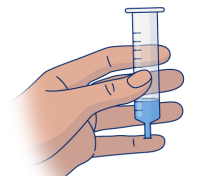This information explains how and why to thicken your liquids. It also lists liquids to include and avoid for people who can only have thick liquids.
Why do I need to thicken my liquids?
You may need to thicken your liquids if you have dysphagia (dis-FAY-jee-uh). Dysphagia is when you have trouble chewing or swallowing. Thicker liquids lower your risk of choking or coughing on the liquids you drink.
Thin liquids, such as water and milk, flow down your throat quickly. This can make them unsafe. Thicker liquids go down your throat more slowly. This makes them easier to control and safer to swallow. It also lowers your risk of choking or coughing on the liquids you drink.
How do I thicken my liquids?
You will add an ingredient to liquids called a thickener. SimplyThick® and Thick and Easy® are examples of thickeners.
There are different thickness levels. Your speech language pathologist will tell you which thickness level is right for you. Write your thickness level on the line below.
If you have questions or want to make an appointment with your speech language pathologist, call 212-639-5856.
Where can I buy a thickener?
You can buy a thickener at your local pharmacy (such as Walgreens or CVS) or online (such as on Amazon). You do not need a prescription.
How much thickener will I need to add to my liquids?
Liquids need different amounts of thickener. For example, some shakes may be the right thickness already. But you may need to add thickener to other drinks to make them the right thickness. Follow the directions that come with the thickener product.
Make sure to thicken your liquids to the level your care team recommends. Follow the instructions in the “How can I check the thickness of my liquids?” section to make sure they’re thickened to the right level.
Can I add thickener to any liquid?
No. Foods that become thin liquids at room temperature cannot be thickened. Here are some examples.
- Ice cream
- Frozen yogurt
- Sherbet
- Slushy drinks
- Gelatin, such as Jell-O®
What are the different levels of liquid thickness?
The International Dysphagia Diet Standardisation Initiative (IDDSI) made a scale for describing the thickness of liquids. Your speech language pathologist will tell you how thick to make your liquids. Here are the different thickness levels.
Level 1: Slightly thick
These liquids:
- Are a little thicker than water.
- Can be sucked through a standard straw easily.
Level 2: Mildly thick
These liquids:
- Can be sipped from a cup.
- Can be sucked through a standard straw with some effort.
Level 2 liquids used to be called nectar thick liquids.
Level 3: Moderately thick
These liquids:
- Can be sucked through a wide straw with some effort.
- Take a little more time to swallow. Your tongue will need to hold the liquid in your mouth before you swallow it.
- Are drinkable with a cup or a spoon.
Level 3 liquids used to be called honey thick liquids.
How can I check the thickness of my liquids?
You can check the thickness of your liquids by doing a flow test. Follow these steps to do a flow test. Make sure to check the thickness of each liquid you drink.
-
Get your supplies. You will need:
- 2 (10 milliliter (mL)) syringes
- A stopwatch, timer, or watch. You can use the timer on your smart phone.
- Take the plunger out of 1 syringe (see Figure 1).

Figure 1. Take plunger out of syringe
- Cover the end of the syringe with your finger.
- Fill the syringe with 10 mL of your liquid. You can use the other syringe to do this more easily (see Figure 2).

Figure 2. Fill syringe with 10 mL liquid
- Take your finger off the end of the syringe and start your stopwatch at the same time (see Figure 3).

Figure 3. Take finger off syringe tip
- Wait 10 seconds, then put your finger back on the end of the syringe to stop the liquid from flowing out (see Figure 4).

Figure 4. Cover syringe tip after 10 seconds
-
Check to see how much liquid is still in the syringe.
- The liquid is level 1: slightly thick if there is 1 to 4 mL in the syringe after 10 seconds.
- The liquid is level 2: mildly thick if there is 4 to 8 mL in the syringe after 10 seconds.
- The liquid is level 3: moderately thick if there is 8 mL or more in the syringe after 10 seconds.
What can I drink on a diet of thick liquids only?
Your speech language pathologist may recommend you follow a thick liquid only diet. This means it is not safe to have thin liquids, regular food, soft food, or pureed food. Your speech language pathologist will tell you how thick to make your liquids.
Here are some drinks to include and avoid while following a thick liquid only diet. Remember to check the thickness of your liquids with the flow test.
Milk and dairy
| Milk and dairy to include | Milk and dairy to avoid |
|---|---|
|
|
Meats and meat substitutes
| Meats and meat substitutes to include | Meats and meat substitutes to avoid |
|---|---|
|
|
Breads and cereals
| Breads and cereals to include | Breads and cereals to avoid |
|---|---|
|
|
Soups
| Soups to include | Soups to avoid |
|---|---|
|
|
Fats
| Fats to include | Fats to avoid |
|---|---|
|
|
Drinks
| Drinks to include | Drinks to avoid |
|---|---|
|
|
Fruits
| Fruits to include | Fruits to avoid |
|---|---|
|
|
Vegetables
| Vegetables to include | Vegetables to avoid |
|---|---|
|
|
Sweets and desserts
| Sweets and desserts to include | Sweets and desserts to avoid |
|---|---|
|
|
Other
| Other things to include | Other things to avoid |
|---|---|
|
|
Sample menu for a thick liquid only diet
Use this sample menu to get ideas for making your own meals when following a thick liquid only diet.
| Thick liquid only diet menu | |
|---|---|
| Breakfast |
|
| Mid-morning snack |
|
| Lunch |
|
| Mid-afternoon snack |
|
| Dinner |
|
| Evening snack |
|
Contact information
If you have questions or want to make an appointment with a clinical dietitian nutritionist, call 212-639-7312.
